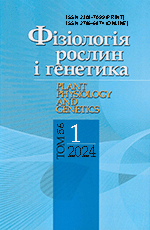Halauxifen-methyl is a new synthetic auxin, which in combination with another auxin-like herbicide clopyralid is the active ingredient of complex herbicide GF-3488, that is used for dicotyledonous weeds control in winter oilseed rape crops. The reason of this study was a necessity to test crop selectivity and efficacy of GF-3488 to control dicotyledonous weeds in winter oilseed rape crops in Ukraine and also the possibility of GF-3488 application in the tank mixture with graminicide or/and insecticide to control monocotyledonous weeds and insects. A randomized block experiment was conducted in 2015—2017 in 4 locations. It was found that under spring applying, the GF-3488 is not inferior to another widely used herbicide Galera Super on selectivity to the crop. Herbicide GF-3488 at the rate 1.0 l/ha was significantly better than Galera Super at the rate 0.3 l/ha in controlling of annual dicotyledonous weeds Papaver rhoeas L., Galium aparine L., Consolida regalis S.F. Gray and was effective to control of certain types of cruciferous weeds, which are resistant to Galera Super. Adding graminicide Fusilade Forte and insecticide Nurelle D did not affect the GF-3488 selectivity to the crop and had no negative impact on dicotyledonous weeds control. Efficacy of monocotyledonous weeds control by graminicide did not change in the mixture with GF-3488. It was concluded that herbicide GF-3488 is effective on winter oilseed rape against dicotyledonous weed species. Therefore for the simultaneous control of dicotyledonous and monocotyledonous weeds in winter oilseed rape in the spring after the renewal of the crop vegetation herbicide GF-3488 is advisable to be used in a tank mixture with graminicides, and for simultaneous protection against weeds and pests it can be mixed with insecticides.
Keywords: Brassica napus L. var. oleifera, winter oilseed rape, herbicides, insecticides, halauxifen-methyl, clopyralid, fluazifop-p-butyl, weed control
Full text and supplemented materials
Free full text: PDFReferences
1. ArylexTM Active - Technical Bulletin. (2013). Retrieved from http://www.arylex. com/en
2. Schmitzer, P.R., Balko, T., Satchivi, N.M. & Weimer, M.R. (February 6-7, 2013). XDE-729 methyl a new post-emergent dicotyledonous herbicide for cereal grains. In: Proceedings of the Annual Meeting of the Weed Science Society of America and the Northeastern Weed Science Society (Abstract 259), Baltimor.
3. Kraehmer, H., Almsick, A., Beffa, R., Dietrich, H., Eckes, P., Hacker, E., Hain, R., Strek, H.J., Stuebler, H. & Willms, L. (2014). Herbicides as weed control agents: State of the art: II. Recent achievements. Plant Physiology, 166, No. 3. pp. 1132-1148. https://doi.org/10.1104/pp.114.241992
4. Pat. 8912120B2 US. Herbicidal compositions comprising 4-amino-3-chloro-5-fluoro-6-(4-chloro-2-fluoro-3-methoxyphenyl) pyridine-2-carboxylic acid or a derivative thereof and synthetic auxin herbicides. Yerkes, C.N., Mann, R.K., Satchivi, N.M., Schmitzer, P.R. Publ. 16.09.2014.
5. Rafalskyj, V.V., Vashchenko, V.M. Chajkovska, V.V. (Eds.) (2019). Addition to the list of pesticides and agrochemicals approved for use in Ukraine. Kyiv: Yunivest Media [in Ukrainian].
6. Focke, M., Gieringer, E., Schman, S., Jansch, L., Binder, S. & Braun, H. (2003). Fatty acid biosynthesis in mitochondria of monocotyledonouses: malonyl coenzyme A is generated by mitochondria-localized acethyl-CoA carboxylase. Plant Physiology, 133, No. 2. pp. 875-884. https://doi.org/10.1104/pp.103.027375
7. Morderer, Ye.Yu., Lukyanchenko, O.S. & Rodzevich, O.P. (2007). Efficacy and selectivity of the herbicide Galera 334 SL in crops of rape and mustard. Quarantine and plant protection, 53. pp. 198-209 [in Ukrainian].
8. Morderer, Ye.Yu. & Merezhynsky, Yu.G. (2009). Herbicides. Mechanisms of action and practice. Kyiv, Logos [in Ukrainian].
9. Mueller, T.C, Witt, W. & Barrett, M. (1989). Antagonism of johnsonmonocotyledonous control with fenoxaprop, haloxyfop and sethoxydim by 2,4-D. Weed Technology, 3, No. 1. pp. 86-89. https://doi.org/10.1017/S0890037X00031377
10. Dechamps, J.A. & Hsiao, W.A. (1990). Quick Antagonistic effect of MCPA on fenoxaprop activity. Weed Science, 38, No. 1. pp. 62-66. https://doi.org/10.1017/S0043174500056125
11. Mueller, T.C, Barrett, M. & Witt, W. (1990). A basis for the antagonistic effect of 2,4-D on haloxyfop-methyl toxicity to johsonmonocotyledonous (Sorghum halepense). Weed Science, 38, No. 2. pp. 103-107. https://doi.org/10.1017/S0043174500056216
12. Kreuz, K. & Fonne-Pfister, R. (1992). Herbicide-insecticide interaction in maize: malathion inhabits cytochrome P-450-dependent primisulfuron metabolism. Pesticide Biochemistry and Physiology. 43, No. 3. pp. 232-240. https://doi.org/10.1016/0048-3575(92)90036-Y
13. Baerg, R., Barrett, M., & Polge, N. (1996). Insecticide and insecticide metabolite interactions with cytochrome P-450 mediated activities in maize. Pesticide Biochemistry and Physiology, 55, No. 1. pp. 10-20. https://doi.org/10.1006/pest.1996.0030
14. Altman J. (2018). Pesticide Interactions in Crop Production: Beneficial and Deleterious Effects. Boca Raton, CRC Press. https://doi.org/10.1201/9781351075459
15. Norsworthy, J.K., Ward, S.M., Shaw, D.R., Llewellyn, R.S., Nichols, R.L., Webster, T.M., Bradley, K.W., Frisvold, G., Powles, S.T., Burgos, N.R., Witt, W.W. & Barrett, M. (2012). Reducing the risk of herbicide resistance: best management practices and recommendation. Weed Science, Special Issue, pp. 31-62. https://doi.org/10.1614/WS-D-11-00155.1
